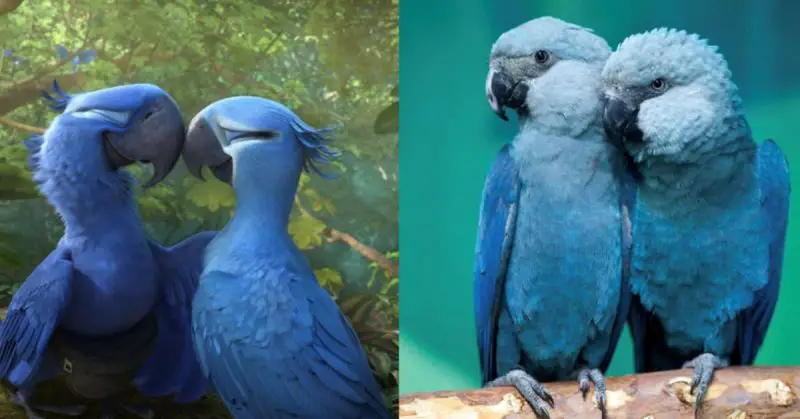You’d be surprised how much research goes into creating an animated movie and how correct most of what you see actually is. In the case of the animated film Rio, a pair of Blue Macaw birds who played a big role is now officially extinct.
Who remembers the blue macaw bird in the movie Rio who was aptly named Blu? Well, here’s a refresher for those who don’t. Rio was a 2011 American animated movie about a blue macaw bird named Blu who thought he was the last of his species.
Blu attempts to fly all the way from Minnesota to Rio de Janeiro to find a mate where he eventually comes across a free-spirited female macaw named Jewel who teaches him several valuable life lessons. The two birds escape from being smuggled by a cockatoo called Nigel, fall in love, and have a baby.
Real Life Has a Different Ending
The movie ends with the hope that the lovebirds would be able to save their species. However, unlike the movie where everyone lives happily ever after, the real world proves to be a totally different experience as Blu’s nightmare has come to life.
According to a new study by the Biological Conservation, the blue macaw, which is native to Brazil and known for its sharp, almost electric blue color, is now officially extinct in the wild. They were declared to be an endangered species about seven years ago.
BirdLife International, a world leader in bird conservation, claims that the blue macaw has gone extinct in the wild due to deforestation. The species made their home in the now-rare Caraibeira trees, which have been felled in high numbers over the past few centuries leaving the macaw homeless. [1]
This isn’t news as experts have been warning about the dangers of habitat extinction on the dwindling blue macaw population as far back as the 1980s. Author Tony Juniper published a book about the phenomenon titled, Spix’s Macaw: The Race to Save the World’s Rarest Bird.
Unfortunately, the blue macaw isn’t the only bird species affected by this. A recent assessment of the World’s Critically Endangered species has confirmed that over eight bird species, including two species of macaw, have gone extinct.
Bird species like Hawaiian Poo-Uli, the Brazilian Alagoas foliage gleaner and the cryptic tree-hunter have already been completely wiped out and are now extinct forever.
“Ninety percent of bird extinctions in recent centuries have been of species on islands,” says Dr. Stuart Butchart, BirdLife’s Chief Scientist and lead author on the paper. “However, our results confirm that there is a growing wave of extinctions sweeping across the continents, driven mainly by habitat loss and degradation from unsustainable agriculture and logging.” [2]
Thank God for Conservationists
Thankfully, some blue macaws still survive in protected breeding programs. Experts estimate their population in captivity to be around 60—80, hence the classification change to Extinct in the Wild.
Even though conservationists, which refers to both a conservation movement and a member of such movement, are concerned with a wide range of natural preservation, their primary focus is protecting the environment from the damaging effects of human activity. This is more important today with increasingly extreme weather events caused by the growing tide of human-caused climate change and the rampant expansion of urban areas. [3]
Conservationist movements like BirdLife International are actively working to protect the world’s wildlife, both flora and fauna, from severe evolutionary changes as a result of the human expansion on earth that has left many of the world’s animals in an adapt-or-die situation.
The Unseen Dangers of Extinction
Although the extinction of certain animal species is a natural part of the evolutionary process, the recent population boom of the human species has led to a significant increase in the rate of extinction. As humans share the world’s ecosystems with these endangered species, the quality of our lives and even our survival are linked to them.
For instance, the American bison, which was a common animal on the central plains and thus an important food source for the Native Americans of the region. However, they nearly vanished in the 19th century as a result of overhunting and the tribes that were dependent on them had to move to new lands in search of food.
Another significant wave of extinction that could potentially affect humans negatively is that of bees, which are responsible for pollinating more species of fruit-bearing plants than any other system available today.
Climate change, destruction of the natural habitat, depletion of resources, and other factors have increased the natural extinction rate of most animals by over 1,000 percent and put pressure on thousands of the planet’s most endangered organisms. [4]
Reference:
- “Blue macaw parrot extinct in wild, study concludes“, The Hill. September 2018.
- “Spix’s Macaw heads list of first bird extinctions confirmed this decade“, BirdLife. September 2018.
- “Blue macaw parrot that inspired “Rio” is now officially extinct in the wild”, CBS News. September 2018.
- “How Do the Extinctions of Other Creatures Affect Humans Directly?”, Sciencing. March 2018.

